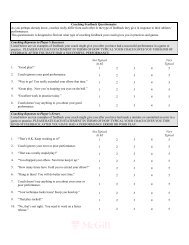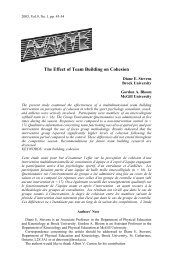International Journal of Sport Psychology
International Journal of Sport Psychology
International Journal of Sport Psychology
You also want an ePaper? Increase the reach of your titles
YUMPU automatically turns print PDFs into web optimized ePapers that Google loves.
Exploring the multiple dimensions <strong>of</strong> social support<br />
among elite female adolescent swimmers<br />
KRISTINA HASSELL, CATHERINE M. SABISTON, and GORDON A. BLOOM<br />
McGill University, Canada<br />
340<br />
Int. J. <strong>Sport</strong> Psychol., 2010; 41: 340-359<br />
This study concurrently explored multiple dimensions <strong>of</strong> social support <strong>of</strong><br />
nine elite female adolescent swimmers. Data were collected and analyzed using the<br />
principles <strong>of</strong> constructivist phenomenology. Results highlighted the importance <strong>of</strong><br />
the structural, functional, and perceptual social support dimensions on athletes’<br />
experiences in elite swimming in relation to their coaches, parents, and peers.<br />
Coaches were an important provider <strong>of</strong> almost every aspect <strong>of</strong> social support. Parents<br />
provided social support on a more general level, with their swimming-specific<br />
informational support being the single most unappreciated aspect <strong>of</strong> social support.<br />
Teammates provided a sense <strong>of</strong> affiliation and shared experience that was described<br />
as the most positive aspect <strong>of</strong> their swimming involvement. The current qualitative<br />
findings provide new insights into the concurrent structural, functional, and perceptual<br />
dimensions <strong>of</strong> social support in female youth elite sport.<br />
KEY WORDS: Adolescence, Elite sport, Social influences, Social support.<br />
Structured sport is a popular leisure-time activity for North American<br />
youth (Shern<strong>of</strong>f & Vandell, 2007). Many children and adolescents report<br />
sport participation motives that generally relate to perceptions <strong>of</strong> enjoyment,<br />
social affiliation, and competence (Weiss & Williams, 2004). Despite this,<br />
sport withdrawal peaks by the ages <strong>of</strong> 13-15 years and more adolescent girls<br />
than boys drop out <strong>of</strong> sport (Weiss & Williams, 2004). Moreover, female athletes<br />
have reported lower perceptions <strong>of</strong> competence in sport and received<br />
less praise from coaches compared to males (Black & Weiss, 1992). Finally,<br />
females have generally been underrepresented in sport psychology research<br />
over the last few decades (Conroy, Kaye, & Schantz, 2008) – and a particular<br />
under-representation has been youth elite sport athletes.<br />
For correspondence: Catherine Sabiston, 212-475 Pine Avenue West, Montreal, Quebec,<br />
H2W 154, Canada. (e-mail: catherine.sabiston@mcgill.ca).




